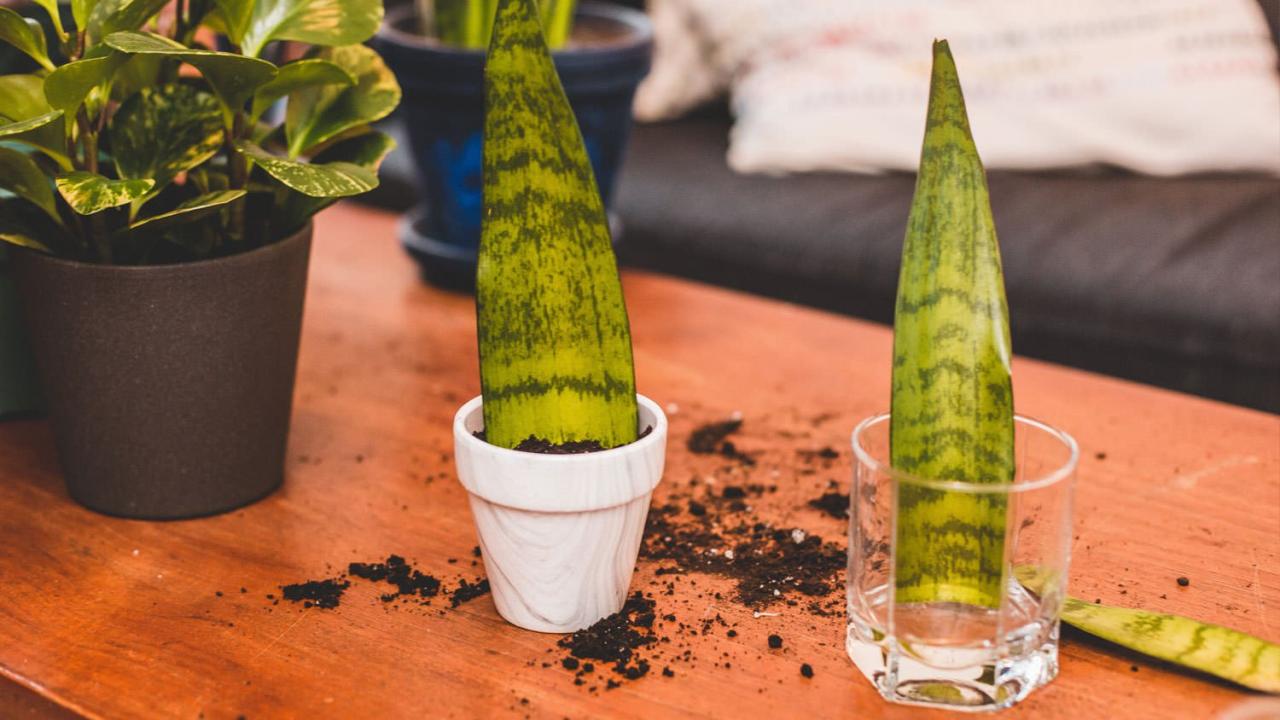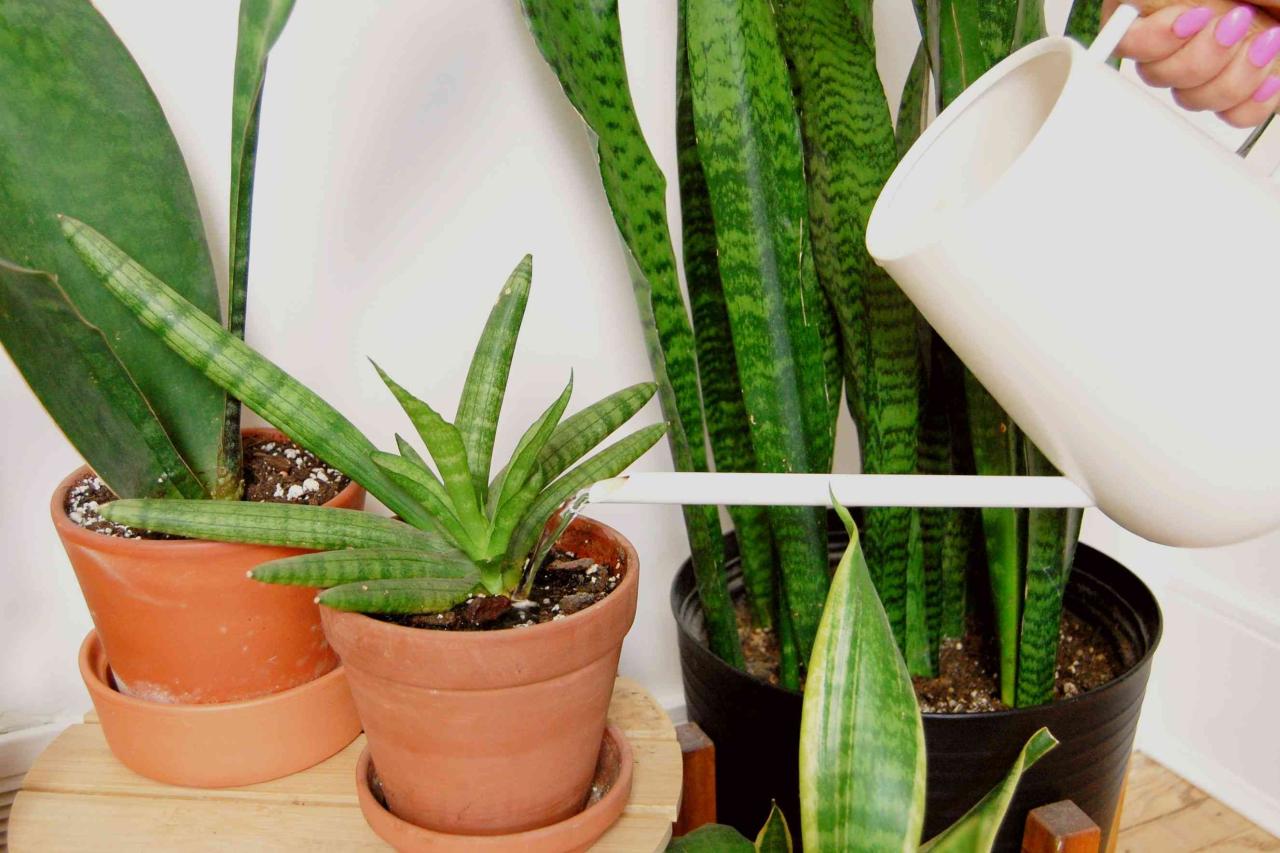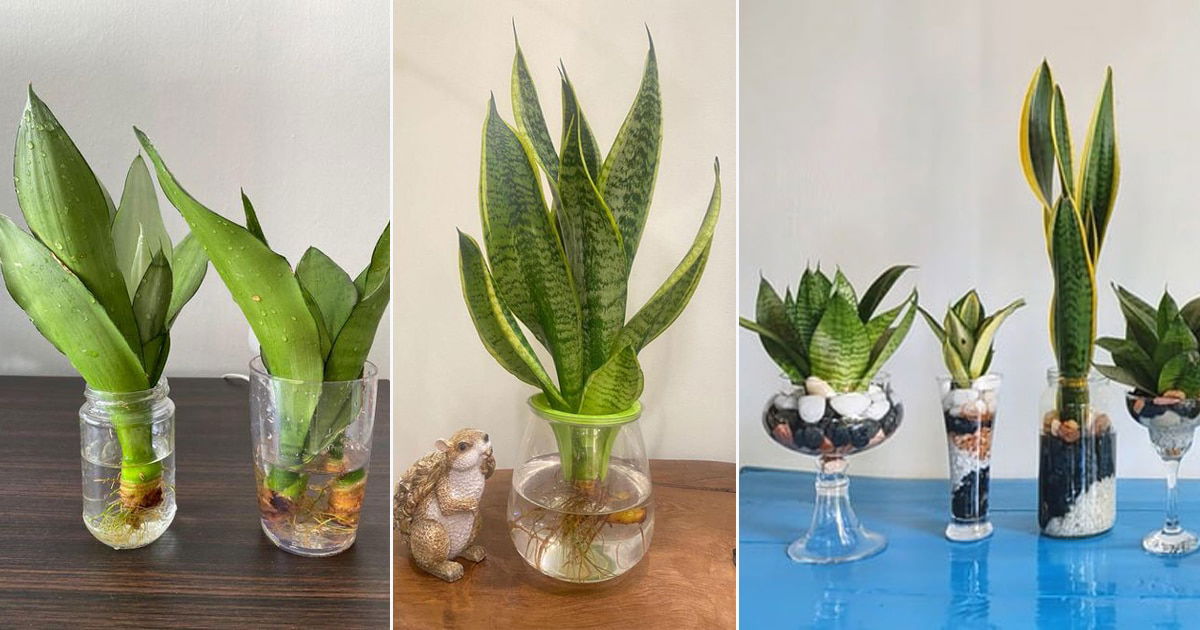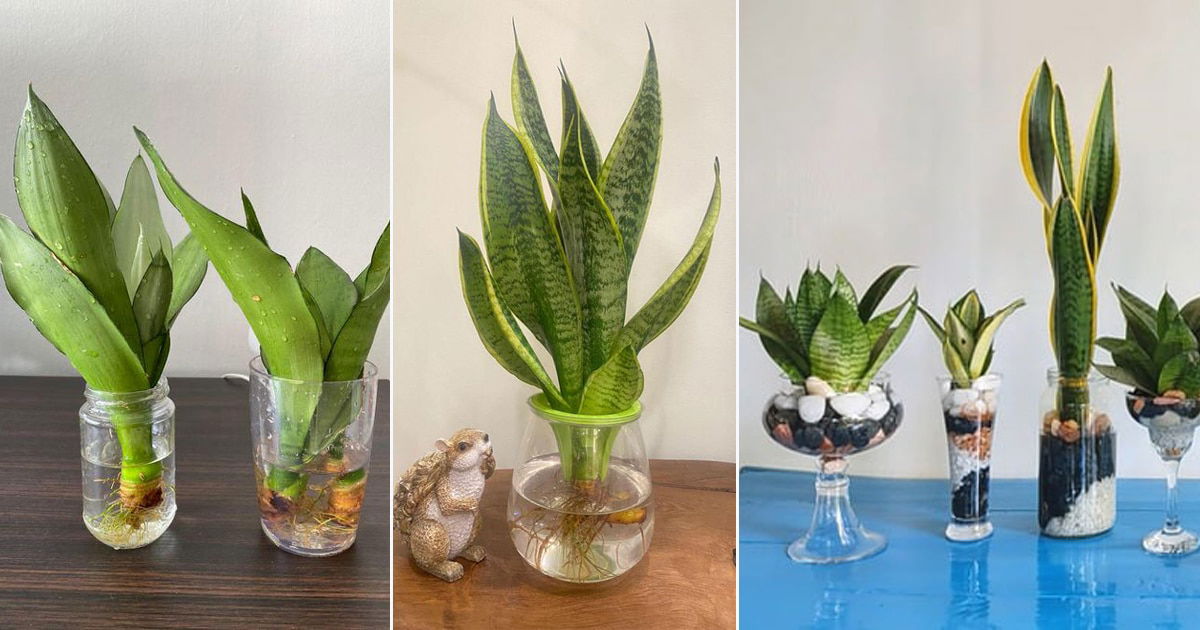The Do’s and Don’ts of Watering Snake Plants: Snake plants, with their striking vertical foliage, are a popular choice for indoor gardeners. These resilient plants are known for their ability to thrive in a variety of conditions, but even the most adaptable snake plant can suffer from improper watering.
Understanding the nuances of watering these succulents is crucial to their health and longevity. From the frequency and amount of water to the type of water you use, there are several factors to consider when keeping your snake plant happy and hydrated.
This guide will delve into the essential do’s and don’ts of watering snake plants, providing you with the knowledge to create a thriving indoor oasis. We’ll explore the unique water storage capabilities of these plants, the importance of soil type and drainage, and the visual cues that signal proper or improper hydration.
By understanding the science behind watering snake plants, you can avoid common mistakes and ensure that your plant flourishes for years to come.
Understanding Snake Plant Watering Needs: The Do’s And Don’ts Of Watering Snake Plants

Snake plants are known for their resilience and ability to thrive in various conditions, making them popular houseplants. However, their water requirements are unique and require careful consideration.
Understanding Snake Plant Water Storage
Snake plants have evolved to store water in their thick, fleshy leaves. This adaptation allows them to survive periods of drought. Their leaves are covered in a waxy coating that helps to prevent water loss through transpiration.
The Importance of Soil Type and Drainage
The soil type plays a crucial role in snake plant watering. A well-draining potting mix is essential for preventing root rot. A suitable mix should contain a combination of ingredients like perlite, pumice, and coco coir, which provide good aeration and drainage.
Assessing When to Water a Snake Plant
Determining when to water a snake plant requires a careful assessment of its needs. Here’s how to check if your snake plant needs watering:
- Feel the soil:Insert your finger about 2 inches deep into the soil. If the soil feels dry to the touch, it’s time to water.
- Observe the leaves:Wilting or drooping leaves are a sign of dehydration. However, snake plants are known for their resilience, and a slight droop may not necessarily indicate a need for watering.
- Check the weight:A well-hydrated snake plant will feel heavier than a dry one. Lift the pot and assess its weight.
The Do’s of Watering Snake Plants
Watering snake plants correctly is crucial for their health and vitality. These resilient plants can tolerate some neglect, but they thrive with consistent and appropriate watering. Here are the key do’s to ensure your snake plant flourishes.
Watering Frequency and Amount
The ideal watering frequency for snake plants depends on several factors, including the season, the size of the pot, and the type of soil. However, a general rule of thumb is to water when the top inch of soil is completely dry.
When it comes to watering snake plants, the key is to err on the side of under-watering. These hardy plants thrive on neglect and can tolerate dry periods. Just like choosing the right pot for a bonsai tree, Bonsai Pot Designs: Choosing the Best for Indoor Trees , selecting the right container for your snake plant can impact its health and drainage.
Too much water can lead to root rot, so always allow the soil to dry out completely between waterings.
This usually translates to watering every 2-4 weeks during the growing season (spring and summer) and less frequently during the dormant period (fall and winter).The amount of water you use should be enough to thoroughly moisten the soil, but not so much that it becomes soggy.
Excess water can lead to root rot, which is a common problem for snake plants. It’s best to err on the side of underwatering than overwatering.
Optimal Watering Schedule for Snake Plants
| Season | Environment | Watering Frequency ||—————–|———————-|——————–|| Spring/Summer | Warm and humid | Every 2-4 weeks || Spring/Summer | Cool and dry | Every 3-6 weeks || Fall/Winter | Warm and humid | Every 4-6 weeks || Fall/Winter | Cool and dry | Every 6-8 weeks | Note:This is just a general guideline.
Adjust the watering frequency based on your specific plant’s needs.
Benefits of Filtered or Distilled Water
Using filtered or distilled water for snake plants can offer several benefits. Tap water often contains minerals like chlorine, fluoride, and salts that can build up in the soil and harm the plant. These minerals can also make the water harder, which can hinder the plant’s ability to absorb nutrients.Filtered or distilled water removes these harmful minerals and impurities, creating a cleaner and more suitable environment for your snake plant’s roots.
This can help prevent mineral buildup in the soil, promote healthy root growth, and enhance the overall health and vigor of your plant.
The Don’ts of Watering Snake Plants

While snake plants are known for their resilience, they can still suffer from improper watering practices. Overwatering and underwatering are two common mistakes that can lead to various issues, affecting the plant’s health and appearance. Understanding these mistakes and their consequences is crucial for ensuring the longevity and vitality of your snake plant.
The Dangers of Overwatering Snake Plants
Overwatering is one of the most common reasons for snake plant decline. When the soil remains consistently moist, it creates an environment conducive to root rot, a fungal disease that can damage and eventually kill the plant’s roots. This can lead to a range of symptoms, including yellowing leaves, wilting, and a mushy texture in the base of the plant.
Understanding the nuances of watering snake plants is key to their thriving. While they are known for their resilience, overwatering can be detrimental. Just as selecting the right pot is crucial for a bonsai’s health and aesthetics, choosing the appropriate container for your snake plant plays a significant role in its well-being.
Top Tips for Picking the Perfect Bonsai Pot provides valuable insights that can be applied to choosing the ideal pot for your snake plant, ensuring proper drainage and preventing root rot. By following these guidelines, you’ll be well on your way to cultivating a healthy and vibrant snake plant.
- Yellowing leaves: Overwatering can cause the leaves to turn yellow due to the lack of oxygen reaching the roots. This can also indicate that the roots are being suffocated by the excess water.
- Wilting: Although counterintuitive, overwatering can also cause wilting. This occurs because the damaged roots are unable to absorb water efficiently, leading to dehydration.
- Mushy base: A soft or mushy base indicates root rot, a sign of severe overwatering. This is because the excess water creates a breeding ground for fungi that attack the roots.
The Dangers of Underwatering Snake Plants
While overwatering is a common problem, underwatering can also harm snake plants. Snake plants are drought-tolerant and can survive for extended periods without water. However, prolonged underwatering can lead to dehydration and stress, affecting the plant’s growth and appearance.
- Leaf browning: Underwatered snake plants often develop brown tips or edges on their leaves. This occurs because the plant is trying to conserve water by shedding moisture from the leaf tips.
- Leaf curling: When a snake plant is severely dehydrated, its leaves may curl inwards, trying to reduce surface area and minimize water loss.
- Stunted growth: Underwatered snake plants often exhibit stunted growth, as they lack the necessary moisture to produce new leaves and stems.
Reviving an Overwatered Snake Plant, The Do’s and Don’ts of Watering Snake Plants
If you suspect your snake plant is overwatered, it’s important to act quickly to revive it. The following steps can help:
- Remove the plant from its pot: Gently remove the snake plant from its pot to assess the condition of the roots.
- Inspect the roots: Examine the roots for signs of rot, such as a mushy texture, black discoloration, or a foul odor.
- Trim away damaged roots: Using sharp, sterilized scissors, trim away any damaged or rotted roots. Cut back to healthy, firm tissue.
- Repot with fresh soil: Repot the snake plant in fresh, well-draining soil. Choose a pot with drainage holes to prevent waterlogging.
- Allow the soil to dry: After repotting, allow the soil to dry completely before watering again. This will help prevent further root damage.
- Monitor for signs of recovery: Keep a close eye on your snake plant for signs of recovery, such as new growth and a healthy green color.
Signs of Proper and Improper Watering
Understanding the signs of proper and improper watering is crucial for maintaining the health and vitality of your snake plant. By recognizing these visual cues, you can ensure that your plant receives the right amount of moisture, preventing overwatering or underwatering.
Signs of Proper Watering
Properly watered snake plants exhibit several visual cues that indicate they are thriving. These signs include:
- Firm and upright leaves:Healthy snake plants have leaves that are firm to the touch and stand upright, demonstrating their structural integrity and good hydration.
- Vibrant green color:Properly hydrated snake plants display a rich, deep green color, showcasing their healthy chlorophyll production and overall vitality.
- No signs of wilting or drooping:Snake plants that are properly watered maintain their structural integrity and do not exhibit wilting or drooping leaves, which are common signs of dehydration.
Signs of Overwatering
Overwatering is a common problem for snake plant owners, leading to various issues that can negatively impact the plant’s health. The following signs indicate overwatering:
- Yellowing or browning of leaves:When a snake plant is overwatered, its leaves may start to yellow or brown, indicating that the roots are not receiving enough oxygen and are starting to rot.
- Soft and mushy leaves:Overwatering can lead to a loss of structural integrity in the leaves, making them feel soft and mushy. This is a clear sign that the plant is receiving too much water.
- Leaf drop:Overwatering can stress the plant, leading to leaf drop as the plant tries to conserve water and energy.
- Foul odor from the soil:If the soil smells musty or sour, it is a strong indication of overwatering and root rot. This is due to the decomposition of organic matter in the waterlogged soil.
Signs of Underwatering
Underwatering can also harm snake plants, leading to dehydration and stunted growth. The following signs indicate underwatering:
- Wilting or drooping leaves:When a snake plant is underwatered, its leaves will start to wilt and droop, as they lose turgor pressure and become dehydrated.
- Dry and brittle leaves:Underwatering can cause the leaves to become dry and brittle, losing their natural firmness and flexibility.
- Leaf curling:In an attempt to conserve moisture, underwatered snake plants may curl their leaves inward, reducing the surface area exposed to the dry air.
- Slow growth:Underwatered snake plants experience stunted growth as they lack the necessary moisture to support their metabolic processes.
Comparing Overwatering and Underwatering Symptoms
The following table summarizes the key symptoms of overwatering and underwatering in snake plants:
Symptom |
Overwatering |
Underwatering |
|---|---|---|
Leaf Color |
Yellowing or browning |
Green or slightly faded |
Leaf Texture |
Soft and mushy |
Dry and brittle |
Leaf Shape |
Drooping or wilting |
Curling inward |
Soil Condition |
Musty or sour odor |
Dry and crumbly |
Growth Rate |
Slow or stunted |
Slow or stunted |
Ending Remarks

Mastering the art of watering snake plants is a journey of observation and understanding. By carefully monitoring your plant’s needs, adjusting your watering practices accordingly, and paying attention to the subtle signs of its health, you can cultivate a flourishing snake plant that will bring a touch of the tropics to your home.
Remember, patience and consistency are key to success. With a little care and attention, your snake plant will reward you with vibrant, healthy foliage for years to come.
Frequently Asked Questions
How often should I water my snake plant?
The frequency of watering depends on several factors, including the size of the pot, the type of soil, and the environmental conditions. As a general rule, allow the soil to dry out completely between waterings, which may be every 2-4 weeks.
What are the signs of an overwatered snake plant?
Overwatering is a common problem for snake plants. Signs include yellowing leaves, mushy stems, and a foul odor. If you suspect overwatering, immediately remove the plant from its pot and inspect the roots. If the roots are mushy or black, it may be necessary to repot the plant in fresh soil.
What kind of water should I use for my snake plant?
Snake plants prefer water that is free of chlorine and fluoride. Filtered or distilled water is ideal. If you’re using tap water, let it sit for 24 hours to allow the chlorine to evaporate.
